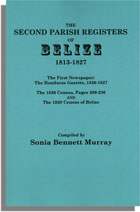
|
|
|
| Product Information: | ||
| Details: | The Second Parish Register of Belize, 1813-1827, with the First Newspaper: the Honduras Gazette, 1826-1827; the 1826 Census, Pages 209-236; the 1829 Census of Belize; by Sonia Murray; 326 pp; Paperback; Published: 2011; ISBN: 9780806355269; Item # CF9343D This volume marks the second collection of early British genealogical records for Belize compiled by Mrs. Sonia Murray from originals at the Belize National Archives in Belmopan. Like its predecessor, this work includes other vital information from supplementary sources. The parish registers comprise about one-third of the volume, and they represent the registers of St. John's for baptism from 1814-1827 and burial for 1813, 1817-18, and 1820-28. (Although the baptismal register was begun in 1811, the earliest surviving entries commence with January 1814.) The baptismal register identifies the name of the infant; the date of, or age at, birth and baptism; the names of parents; and, frequently, the father's occupation. Death records identify the decedent by date of death and occupation, and sometimes by age at death or next of kin. An individual's race is usually so indicated. Not all the individuals referred to in the registers have found their way into the volume's index, as many inhabitants lacked surnames. The short-lived Honduras Gazette was a rich source of local information. Primarily a publication of "shipping news," the newspaper identifies the comings and goings of vessels by name, with the identities of their captains, passengers, cargo, etc. Published from July 1826 to October 1827, it also contained advertisements from local businessmen, outcomes of court cases, coroner's reports, and so forth. Mrs. Murray has captured every nugget of genealogical significance from the Gazette's pages, amounting to the middle third of this work. Census records round out Mrs. Murray's volume. The author discovered the remainder of the 1826 census in a folder at the National Archives subsequent to publication of her 2010 book. The 1829 census gives the names of all heads of household and all family members (but not their ages), and the names and ages of slaves. Like its predecessors, the 1829 census conveys a clear sense of the ethnic makeup of Belize society. Separate columns in the enumeration tabulate the number of men, women, and children in the household in each of four categories: white, colored, black, and slave. Men who were pensioned out of the Army and military widows who married settlers appear in the census, but men on active duty or their families do not. Mrs. Murray's painstakingly transcribed new volume concludes with an index of names, places, and vessels of 6,000 entries. Like the inaugural volume, this one brings the early inhabitants of Belize within the reach of contemporary researchers. |
|

